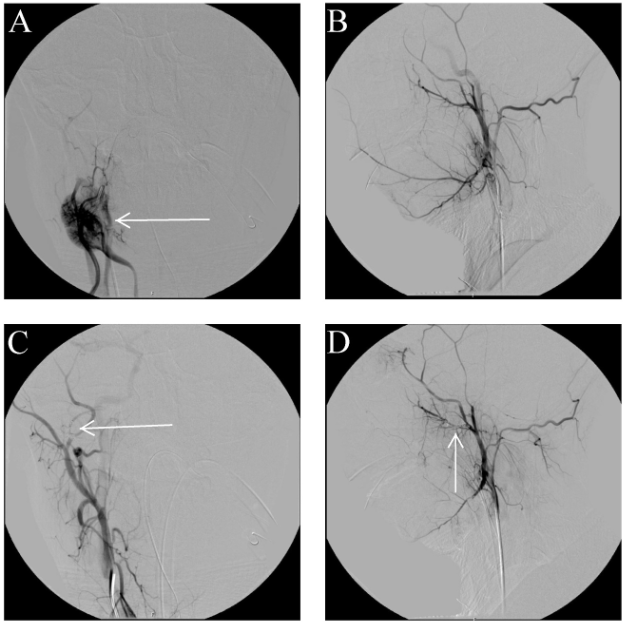An interesting article titled “Pseudoaneurysm following “routine” third molar extraction: a case report and review of the literature” appears in the March 2022 edition of Oral and Maxillofacial Surgery Cases written by J. J. Heifetz-Li and S. Abdelsamie (vol. 8, no. 1,100249). The article presents a case of unusual bleeding following wisdom teeth surgery in a healthy 17 year-old.
In the article discussion is made of a 17 year old teenage woman who has her complete bony impacted wisdom teeth extracted at an Oral and Maxillofacial Surgery outpatient clinic. She had no known signficant past medical history. The removal of her wisdom teeth was considered to be a routine extraction that involved a distal “hockey stick” incision, to raise the full-thickness mucoperiosteal flap to get to the crowns. The teeth were removed without damaging any nerves nearby and no excessive bleeding was observed.
Three days after surgery, the woman returned to the clinic complaining of right facial swelling and bruising, along with pulsating pain, malaise, and fever. An intraoral exam showed inflamed soft tissue around the socket of the extracted lower right wisdom tooth that was bleeding. The surgeon found underneath the soft tissues, brisk bleeding and “liver clots” or incomplete fibrins clotting which presented as slowly developing reddish-brown clots. The inferior alveolar artery was noted to be the source of bleeding. Multiple attempts were made tocontrol the bleeding with oxidized regenerated cellulose, a sterilized compressed sponge, and an adjunct hemostatic agent but to no avail. As a result a decision was made to transfer the woman to an
inpatient setting using an ambulance.
Upon admission to a hospital, the woman had a computed tomography angiography (CTA) with intravenous contrast performed. The imaging scan showed a peripherally enhanced collection of fluid measuring 1.5 × 2.5 cm around the buccal and lingual surfaces of the mandibular body with cortical erosion of the medial surface of the right mandibular ramus and vascular blushing of the infeeding inferior alveolar artery. Interventional radiology was consulted who performed angiography of the right external carotid artery while the patient was under anesthesia. The angiography showed contrast extravasation and a pseudoaneurysm emerging from the woman’s inferior alveolar branch of the right internal maxillary artery. A rapid transit microcatheter was navigated into the right maxillary artery, and a series of detachable coils were deployed across the inferior alveolar artery. Afterwards, the woman was sent to the neurosurgical intensive care unit. The second day after the hospital procedure, the woman was given a blood transfusion as she had a drop in her hemoglobin level from 12 g/dL to 9 g/dL. The fourth day after the hospital procedure, the woman was discharged and told to follow up with oral and maxillofacial surgery and interventional radiology services.

The woman subsequently suffered from self-limited headaches in the months to follow that have decreased in frequency over time. She has had no recurrent episodes of bleeding after it began after the wisdom tooth surgery and she has had no problems with her sensory stimuli.
Pseudoaneurysms like what occured in this case are perivascular hematomas that form after an injury to the artery and are retained by a fibrous pseudocapsule. Most pseudoaneurysms are found in the femoral artery following catheterization and occur at an incidence rate of 0.6% to 6% but can be found anywhere. Pseudoaneurysms have the potential to expand and rupture and are considered vascular emergencies that can be life-threatening. In oral and maxillofacial surgery, most pseudoaneurysms are found in patients who sustained maxillofacial trauma or following orthognathic or microvascular reconstructive surgery. Pseudoaneurysm following wisdom teeth extraction is rare and the authors discuss six different referenes describing ten cases of it occuring in the past. The authors state
“Significant post-operative bleeding is an unusual complication following third molar [wisdom teeth] extractions. While the most common cause of post-operative bleeding is soft tissue injury, pseudoaneurysms, although rare, should be included in the differential diagnosis when bleeding persists despite continued local measures.”
The authors say that a wide array of strategies can be used to treat pseudoaneurysms including surgical ligation with or without excision and intravascular embolization.
